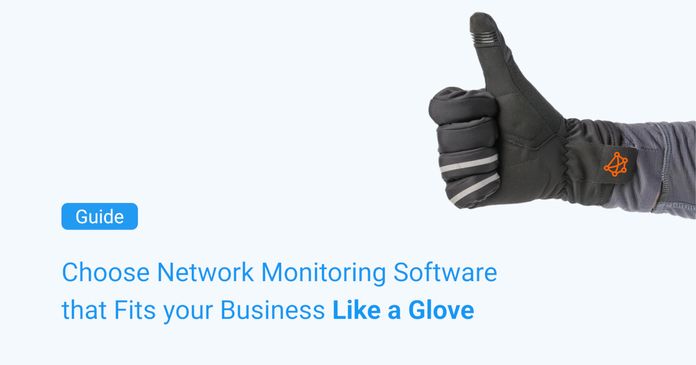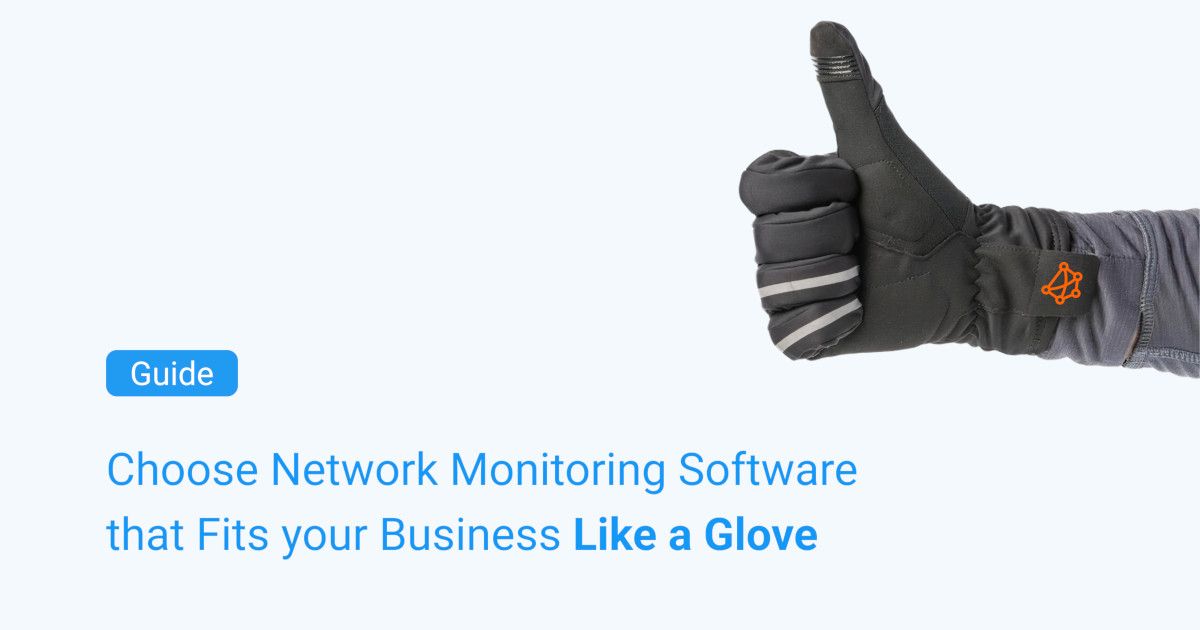Table of Contents
Table of Contents
Just as car owners rely on indicators to track their vehicle's health, you as a network administrator depend on monitoring systems to keep an eye on the network's vital signs. It involves inspecting and addressing various network components, from devices like routers to critical assets like applications and services, user experience and service providers.
In the connectivity world where network reliability is non-negotiable, you must not settle for mediocrity. Embracing the best network monitoring practices and selecting the right tools with advanced features is not just a recommendation – it's a roadmap to network excellence. This article dives into all of that.
Ensuring a well-functioning network is like giving your car regular check-ups, which is essential for optimal performance and longevity. Think of network monitoring software as the diligent mechanic for your digital highways, replacing brake fluid and fine-tuning alignment, but with routers and servers instead of engines and oil filters.
In this parallel universe of network health, the absence of engines and oil filters doesn't make the task any less critical for you. Network monitoring delves into key elements:
- End-to-end monitoring of both LAN and WAN for smooth performance.
- Real-time visibility into network traffic, bandwidth usage, device health, latency, packet loss, error rates and potential security threats.
- Optimizing the performance of cloud services and applications VoIP, UC, ERP, etc.
- Identifying and troubleshooting network issues to improve the end-user experience.
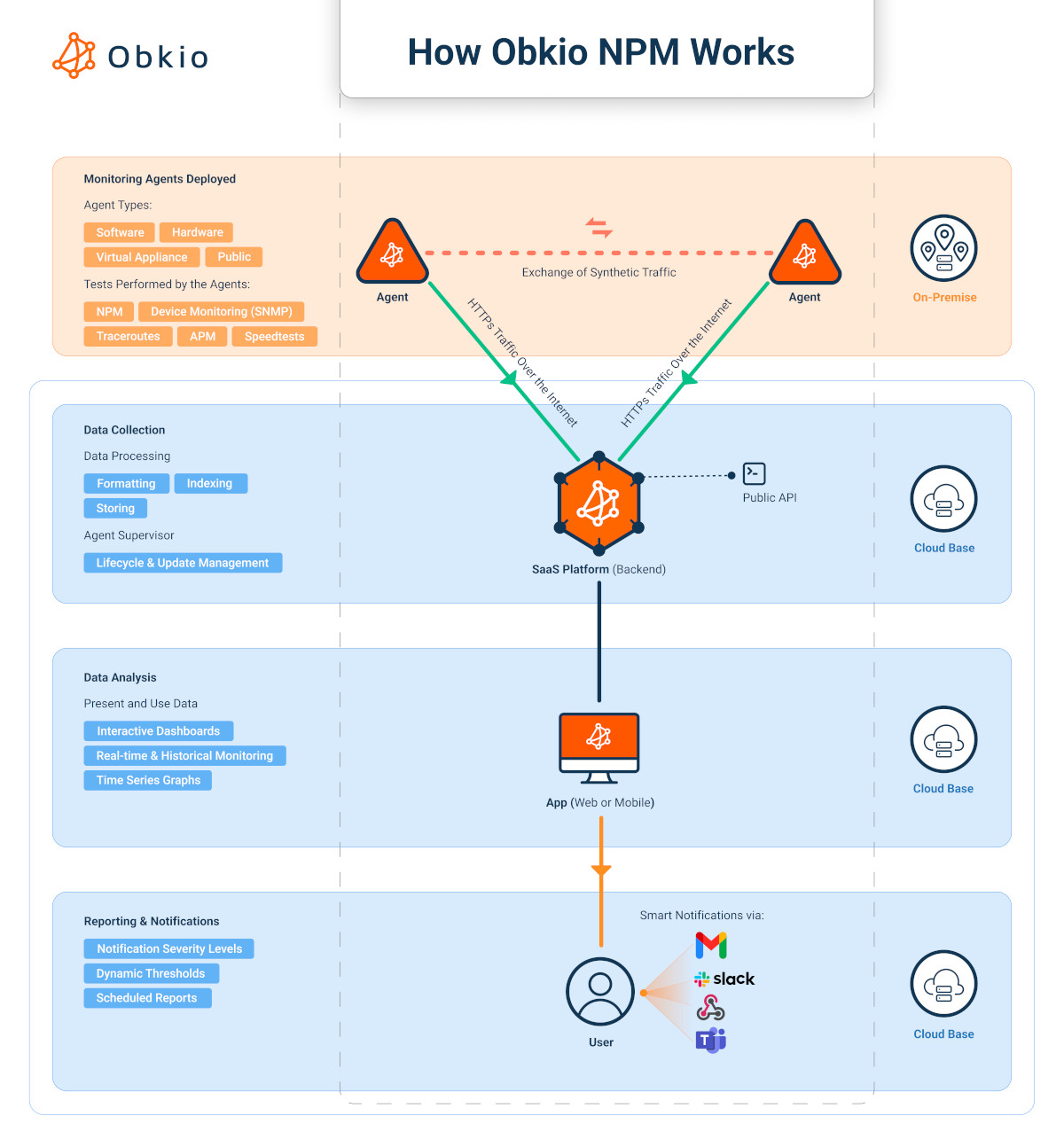
But it doesn't stop there. The Network monitoring definition isn’t just about passive observing, it's about configuring these components, identifying vulnerabilities, and initiating fixes before end users even notice any issues. Our article on Network Monitoring for Dummies goes through these basics.
Just as regular car maintenance enhances lifespan, saves on fuel and part replacements, and preserves resale value, enterprise network monitoring ensures the seamless functioning of your digital ecosystem, safeguarding against potential hiccups, creating productive space for remote workers and optimizing overall operational performance.
That’s what you can tell your boss about the positive impact of integrating the following network monitoring best practices into your company's strategic roadmap.
Elevate your network monitoring strategy, organize your daily routine, and ensure the seamless performance of your network infrastructure with these monitoring and alerting best practices.

Network Monitoring Best Practice #1. Choose the Right Type of Network Monitoring Solution for Your Network and Business
As a network operator, the choice between different types of monitoring tools is a crucial first step that can significantly impact the efficiency and effectiveness of your network monitoring. It's akin to selecting the right tool for the job, where understanding the nuances of each solution is paramount to ensure a seamless and tailored monitoring experience as well as improve business workflow.
Join us as we navigate through some of the options, unveiling the network monitoring best practices and empowering you to make an informed decision for your network's optimal performance.
Active network monitoring is the proactive assessment of network performance through the intentional generation of synthetic traffic. Active network monitoring tools, often use sensors, probes or Monitoring Agents to generate synthetic test packets that simulate typical network interactions and measure various performance metrics such as response time, latency, packet loss, and throughput.
As a Network Admin, You Can:
- Deploy monitoring agents or probes in key network locations for comprehensive end-to-end monitoring.
- Send synthetic data packets across the network, use automated tests or pinging a device to evaluate network performance and find any problems.
- Simulate user behaviour, testing how the network responds under different loads and conditions.
Active monitoring is like having a proactive guard, thus becoming increasingly popular within the NetOps community. It's the first to raise the alarm when something is off, allowing for swift intervention. Additionally, given their distributed nature, active network monitoring tools are capable of keeping an eye on modern decentralized network topologies.
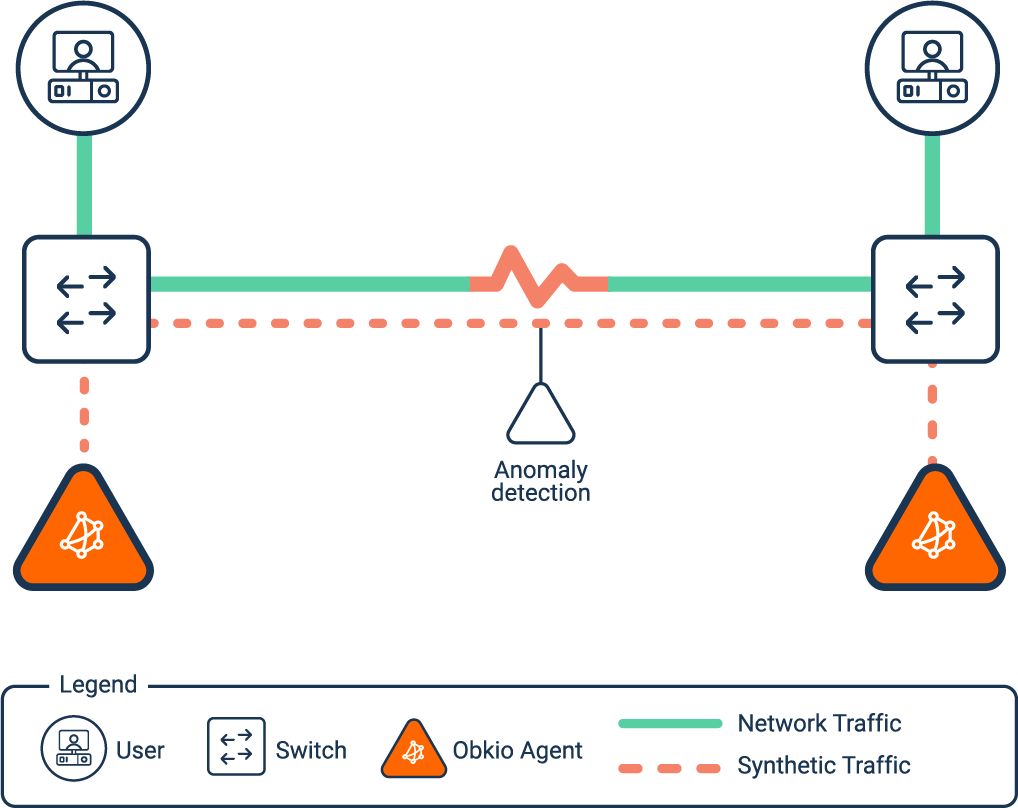
Passive network monitoring takes a backseat, quietly observing network traffic without actively participating in the communication process. It involves capturing and analyzing network packets as they traverse the network, offering a non-intrusive method of monitoring that neither introduces additional network traffic nor latency.
As a Network Admin, You Can:
- Detect unusual traffic patterns, measuring response times, latency, and network congestion.
- Ensure that resources align with priorities and QoS policies.
- Identify whether essential applications receive the necessary bandwidth and resources.
Here’s a more detailed comparison of Active vs. Passive Network Monitoring Solutions.
Discover the differences, benefits, and implementation strategies of active network monitoring vs passive network monitoring.
Learn more

Start with evaluating different network monitoring techniques and select the one that best suits your network's needs. Once the network monitoring method is determined, identify 3 to 5 vendors that are capable of delivering the advantages of network monitoring for your specific topology.
The second part involves requesting quotes, comprehensive proposals, and pricing details from these potential providers. Consider crucial factors such as scalability, flexibility, integration capabilities, customization options, a user-friendly interface, and real-time monitoring features when choosing the right solution tailored to your network structure.
This comprehensive approach ensures that the chosen solution not only aligns with your current requirements but is also equipped to adapt and scale with the evolving demands of your network infrastructure.
If you're on the hunt for the ideal solution to keep your network in top-notch shape, look no further than Obkio! Obkio's Network Performance Monitoring tool has your back when it comes to active network performance monitoring. Don't settle for less—make the smart choice for seamless operations.

Networks may be complex. But Obkio makes network monitoring easy. Monitor, measure, pinpoint, troubleshoot, and solve network problems.
- 14-day free trial of all premium features
- Deploy in just 10 minutes
- Monitor performance in all key network locations
- Measure real-time network metrics
- Identify and troubleshoot live network problems

The impact of selecting the right network monitoring solution extends far beyond the technical realm, significantly influencing both business operations and the daily responsibilities of network administrators. A well-monitored network ensures smooth operations, reducing downtime, and enhancing customer satisfaction. This reliability in services and applications directly contributes to revenue growth, fostering customer loyalty and attracting new business.
Administrators can redirect their focus from constant issue resolution to strategic tasks, enhancing overall efficiency and productivity by automating processes and fostering a proactive approach. Additionally, the chosen solution, aligned with monitoring and alerting best practices, is an investment in the future, seamlessly adapting and scaling with the evolving demands of your network infrastructure.
The architecture of your network, whether a centralized or decentralized network, significantly influences the network monitoring methods you use. Here are some key differences you need to understand about these types of networks before making your choice.
Structure:
- In a centralized network, all control and decision-making reside in a central hub or data center, serving as the nerve center for connectivity and resource access.
- Decentralized networks disperse resources and decision-making across multiple nodes, fostering distributed and autonomous operations.
Redundancy and Fault Tolerance:
- Centralized networks face vulnerability to single points of failure, risking network-wide disruptions with disruptions to the central hub.
- Decentralized networks inherently offer redundancy and fault tolerance, ensuring continued operations even if individual nodes encounter issues.
Scalability and Flexibility:
- Centralized networks may encounter higher latency due to reliance on a central hub for data transmission.
- Decentralized networks exhibit superior scalability and flexibility, seamlessly accommodating new nodes or locations without network-wide disturbances (direct communication between nodes can reduce latency).
In a nutshell, more and more companies have started to embrace the decentralized approach for its inherent advantages, including enhanced resilience, improved security, increased privacy, and empowerment of participants. In addition to those advantages of network monitoring, the distributed structure also ensures uninterrupted visibility even in the face of node failures.
In essence, the best practice for network monitoring involves a thorough evaluation of your network's structure and specific requirements. The chosen tool should seamlessly integrate with your existing network, offering targeted solutions that enhance performance, security, and the overall efficiency of both businesses and network administrators.
Gather references from fellow network administrators operating in similar network structures. Learn from their network monitoring best practices with different vendors and tools. Explore customer feedback from the vendor's customer base, paying attention to reviews and testimonials from users with networks resembling yours. The greater the amount of information available to you, the smoother and more informed your decision-making process becomes.
Imagine implementing a centralized tailored monitoring tool in a decentralized network. The inefficiencies that arise from such a mismatch can lead to missed opportunities for optimizing network performance, potential disruptions, and increased vulnerability to network-wide issues. These consequences can and will ultimately impact the overall success and resilience of your network infrastructure, creating challenges for all business executives, employees, network administrators and end users.

Network Monitoring Best Practice #2. Monitor Every End of Your Network So You’re Not Left in the Dark
Network administrators, despite their expertise, cannot physically oversee every inch of the network at all times. Network monitoring tools serve as the eyes and ears of the network, providing real-time insights into its performance and health.
Emerging from diverse sources, network problems range from internal components to external services. Monitoring agents act as indispensable tools, extending the reach of administrators to every corner of the network:
- Identify potential bottlenecks and optimize the network for efficient data transmission from LAN (all connected devices) to WAN (remote offices, external services, etc.).
- Leverage Simple Network Management Protocol (SNMP) to monitor the health and performance of network devices (routers, switches, and servers – the backbone of network infrastructure). This involves tracking metrics such as CPU usage, memory usage, and device responsiveness, allowing for proactive maintenance and swift issue resolution.
- For VoIP and UC, agents can help you track metrics like latency, call quality and MOS score, ensuring seamless communication.
- When it comes to ERP and CRM, agents monitor data transfer times and application responsiveness, guaranteeing optimal business process management.
- Besides optimizing interactions between your company and Cloud Services, agents will help you track and identify anomalies that could indicate potential security threats.

Traditional monitoring tools typically focus solely on network devices, limiting the scope of information they provide. End-to-end monitoring, on the other hand, offers a comprehensive perspective of your network performance. This approach allows you not only to pinpoint the source of issues but also to identify the specific components of your network that may be impacting the overall user experience.
With monitoring agents, NetOps can see more information about the full scope of possible network performance issues, which are frequently inconsistent and difficult to identify with traditional tools.
Monitoring every end creates a perfect environment for targeted troubleshooting since administrators know the exact source of arising issues network, reducing the time of resolution to minutes rather than hours. Comprehensive monitoring also strengthens network security, ensuring the privacy of user data and mitigating the risk of unauthorized access. All that leads to happy customers who leave your business with full-star reviews.
Armed with detailed insights into network components, administrators can make informed decisions about the source of the issue. This fosters strategic network performance management aligned with monitoring best practices and business goals.
Network Monitoring Best Practice #3. Implement Proactive Monitoring for Preemptive Issue Resolution: Troubleshoot before User Complaints
Monitoring best practices often involves monitoring network performance from the end-user perspective as a strategic approach that puts administrators in the shoes of those who rely on network applications and services daily. By adopting the user's viewpoint, admins can proactively identify potential issues, troubleshoot effectively, and ensure a seamless user experience.
Active or proactive monitoring, also referred to as synthetic monitoring, is a technique used to simulate user activity inside a network to evaluate application and network performance. By stimulating synthetic traffic that mimics actual user and application behaviours, network admins can find and troubleshoot possible network problems before they influence users.
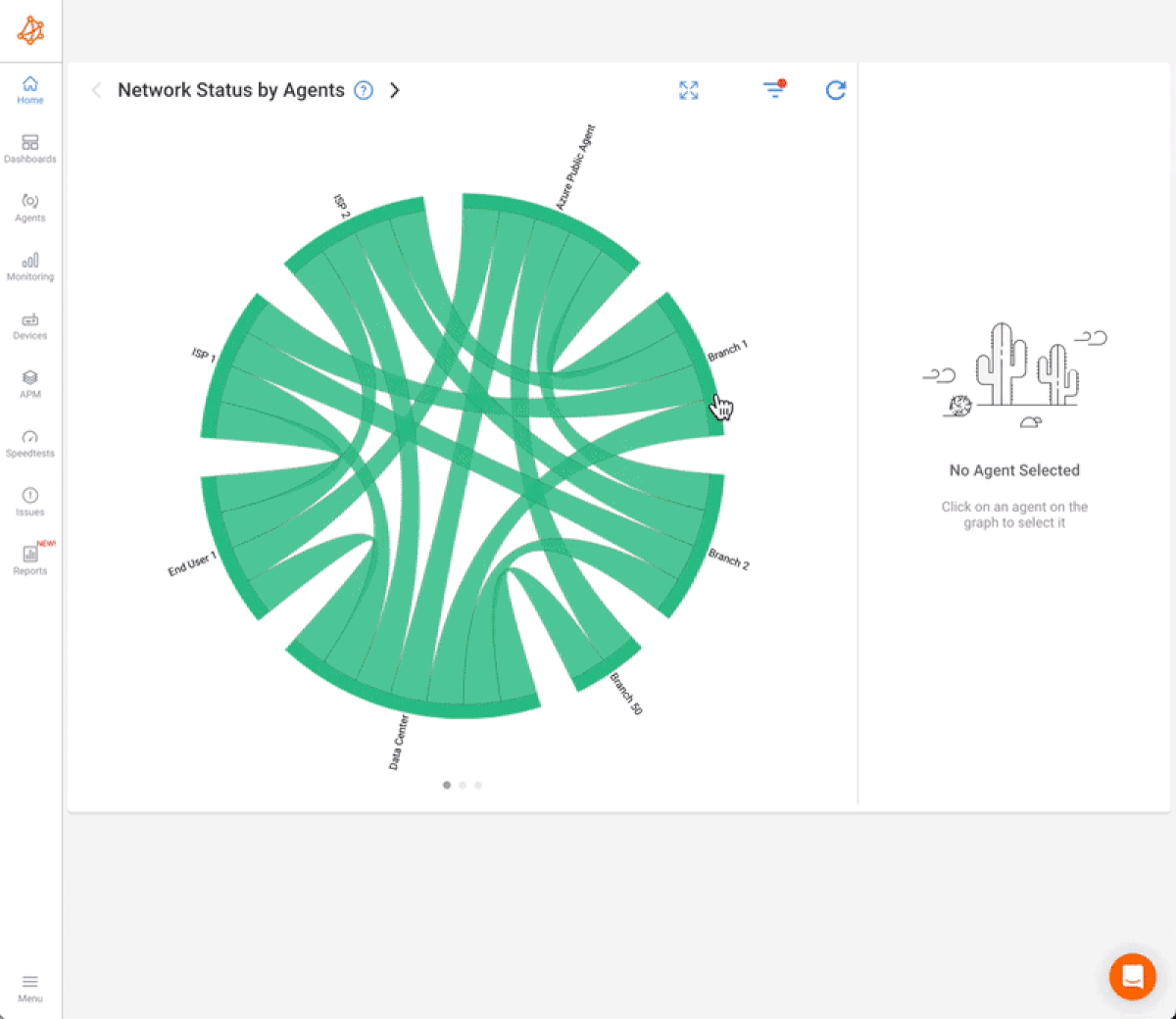
- Addressing network issues proactively before users report them reduces both the impact on user experience and workload for the customer support department.
- Minimizes downtime for network applications and services.
- Decreases the load on network resources, contributing to cost efficiency and streamlined network management.
- Wide range of applications allowing to monitor the performance, availability, and functionality of websites, web & mobile applications, APIs & 3rd-party software, microservices, CDNs (Content Delivery Networks), and DNSs (Domain Name Systems).
The advantages of proactive network monitoring contribute to operational continuity by preventing issues from causing significant disruptions, ensuring business processes run smoothly and meeting the SLA requirements. This approach reduces the need for expensive hardware and infrastructure, as simulated traffic replaces real user traffic. It minimizes network load and helps avoid costly downtime.
With data privacy and security concerns rising, synthetic monitoring emerges as a superior option for businesses seeking to monitor network performance, identify issues, and enhance the end-user experience without checking actual user traffic.
By identifying issues before they impact real users, synthetic monitoring allows administrators to implement preventive measures, ensuring consistent connectivity and low risk of network disruptions.
Synthetic is one of the best network monitoring practices for assessing the performance of e-commerce websites by mimicking user engagements with essential features like shopping carts and checkouts. Identify issues such as prolonged page load times or errors in the checkout process, allowing you to fine-tune the e-commerce experience for your customers.
This guarantees that vital user pathways operate at their best, notifying you of any potential problems that could affect conversion rates or user satisfaction.
Getting your network monitoring up and running ASAP is a game-changer for keeping things smooth. It's all about being proactive rather than waiting to react when problems hit. Think of it like giving your network a dose of preventive medicine—it helps catch and fix issues before they become a big deal.
If you put off starting your network monitoring, you're basically leaving your organization vulnerable to surprise glitches, slow performance, and the dreaded downtime. So, why wait? Get that monitoring going and stay ahead of the curve!
Don't waste your precious time going through endless network monitoring options when we've got the ideal fix ready and waiting.
Level Up Your Network with Obkio's Synthetic Network Monitoring Software!
With a proactive network monitoring approach, Obkio ensures that all potential issues are addressed before they escalate and your overall network performance stays healthy regardless of the size and complexity.

Experience firsthand the advantages of network monitoring best practices with Obkio. Monitor, measure, pinpoint, troubleshoot, and solve network problems.
- 14-day free trial of all premium features
- Deploy in just 10 minutes
- Monitor performance in all key network locations
- Measure real-time network metrics
- Identify and troubleshoot live network problems

Network monitoring best practices extend beyond the binary world of "up" or "down" reports. It's not just about knowing if your network is operational or not, it's similar to the difference between riding a drop tower and a Ferris wheel at an amusement park.

Traditional monitoring tools are like a drop tower, providing a limited and short view of your network's overall status. They may indicate whether your network is up or down, but the nuances of its performance remain hidden.
On the other hand, modern network monitoring software like Obkio is your ticket to the Ferris wheel experience. It takes you on a thrilling ride, providing a detailed, dynamic, and real-time perspective of your network's performance.
Go beyond the basics to have a comprehensive view of your network's health and vitality, with critical metrics such as:
- Latency – the delay or duration that data takes to move between nodes in a network.
- Jitter – the fluctuation in packet arrival time delays throughout a network.
- Packet loss – the drop of data packets while being transported over a network, between devices, or over the Internet, and they are unable to reach their intended destination.
So if your current solution only shows you the status of your network without any of the metrics above, you are running after the train that has already departed.
Sounds somewhat familiar to you, it’s probably a good time to think about switching to another vendor to start implementing network monitoring best practices in your workflow.
Here’s a handy guide that will lead you to the perfect network monitoring solution tailored to your needs in no time!
Confidently navigate the network monitoring tools landscape with our ultimate buyer's guide. Expert insights, use cases, and tips for informed choice
Learn more

- Unlike monitoring solutions that merely signal network status, performance monitoring excels at identifying the earliest signs of degradation.
- By tracking crucial metrics, administrators can detect anomalies and deviations, providing a proactive stance toward network issues.
- Admins can also take preemptive measures to address emerging problems.
Network performance monitoring contributes to operational continuity by preventing disruptions that can impede business processes. The ability to address potential issues before they escalate ensures that critical operations run smoothly, meeting SLA requirements and enhancing overall business resilience.
Network administrators, armed with insights from performance monitoring, can implement preventive measures, ensuring consistent connectivity and reducing the risk of network disruptions. This network monitoring advantage translates into a performance management strategy that is in control, responsive, and aligned with organizational objectives and needs.
Network Monitoring Best Practice #5. Establish a Baseline for Setting Alerts and Proactive Troubleshooting
When it comes to monitoring and alerting best practices, you've got to get down to basics. You need to figure out what's normal for your network, how it usually behaves, what data matters, and what's the sweet spot for network performance. Once you've cracked that code, you've got yourself a baseline.
Think of this network baseline as your network's benchmark point of comparison, like the gold standard of how things should be. It's not just about knowing what good network performance looks like but also recognizing when things go south.
Thus, defining a comprehensive baseline for network performance forms the foundation for effective alert setting and proactive troubleshooting.
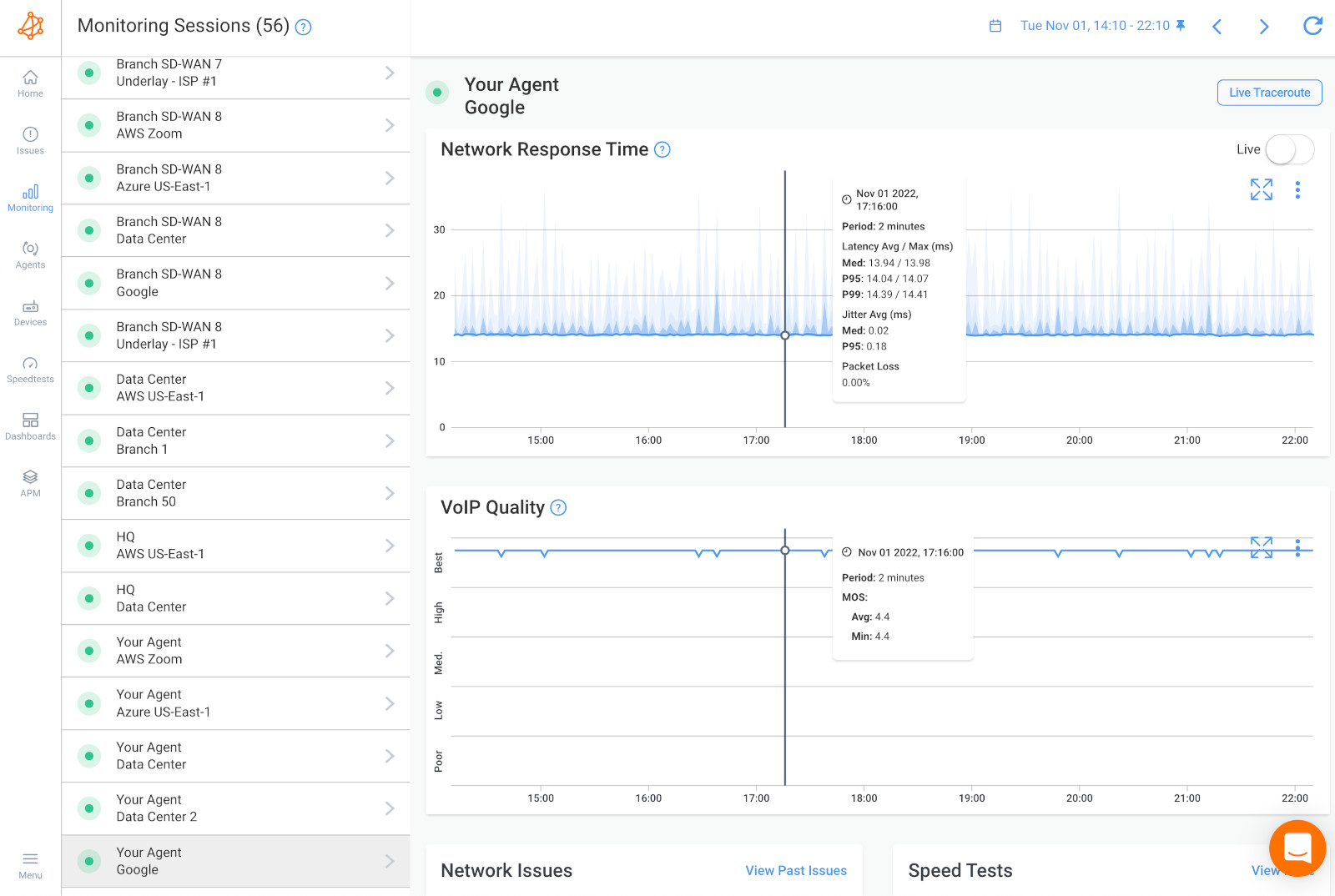
- By having a clear understanding of normal network behaviour, administrators can set precise alert thresholds. This proactive approach allows for timely identification and resolution of potential issues before they evolve into critical failures.
- Historical performance data aids in anticipating future needs. By analyzing trends and patterns, administrators gain insights that enable strategic decisions regarding capacity upgrades, resource allocation, and overall network optimization.
- Setting a performance baseline can be done with a wide range of different network events, including session up/down, latency, packet loss, throughput, jitter, packet reordering, packet duplication, MOS score, and many more.
For example, if the baseline indicates that server CPU utilization usually hovers around 70%, setting an alert for values surpassing 80% can trigger proactive investigation and preventive measures.
Proactive troubleshooting, driven by a well-established baseline, contributes to operational continuity. Network failures and disruptions are minimized, ensuring critical business processes run smoothly and meet SLA requirements.
From the perspective of network administrators, having a baseline streamlines the troubleshooting process. Alerts triggered by deviations from the norm provide early indications of potential problems, allowing administrators to investigate, address, and potentially prevent issues before they impact the end users.


As networks evolve to be both more complex and intricate, effective network monitoring and alerting becomes a critical need for NetOps. Many specialists find themselves stuck with these questions:
How do I monitor the network more effectively? How do I get eyes on the most important elements of the network?
Not all aspects of the network are equally critical, and not every event requires immediate attention. To navigate the complexities, it's essential to adopt a targeted approach that emphasizes the most important components. Make sure to set thresholds and only enable alerts for applications, services, and network locations that are most important.
Tip: Implementing the 80/20 rule can guide the implementation of this monitoring and alerting best practices into your workflow. Focus on the 20% of network monitoring metrics that will likely have an 80% impact on your performance.
- Concentrate on vital elements (throughput, network speed & availability, bandwidth utilization, network error rate, round-trip time, etc.), ensuring that crucial events receive prompt attention.
- Prevents alert fatigue, allowing for a more efficient response to genuine issues.
- Resources can be allocated more efficiently, directing attention and efforts where they are most needed. This optimization leads to a streamlined and proactive network management approach.
The practice of setting network monitoring alerts for only important issues contributes to operational efficiency by preventing distractions caused by constant non-essential notifications from your network monitoring software. By prioritizing critical applications and services, businesses can allocate resources strategically, ensuring that network administrators address high-priority concerns as soon as they occur.
Avoiding constant small alerts can help prevent burnout among network administrators who frequently have to work overtime when alerts are triggered. By concentrating on essential issues, admins can maintain focus and reduce the chance of missing early indicators of critical problems, fostering a healthier and more sustainable work environment.
To effectively monitor network performance, it's essential to build an effective network monitoring dashboard that provides a clear visualization of the most critical data. This involves selecting key metrics, arranging them logically, and customizing the dashboard to align with the organization's specific needs and priorities.
- A well-designed dashboard offers at-a-glance visibility into essential network metrics, saving time for network administrators to assess performance and identify potential issues.
- Avoiding information overload and ensuring that critical insights are easily accessible.
- Enhance clarity with straightforward visualizations like line charts, bar charts, or gauges, preventing dashboard clutter and information overload.
- Integrate widgets or KPIs for quick insights into critical network metrics.
- Embed contextual alerts and notifications within visualizations to highlight anomalies or crucial events.
A user-friendly dashboard simplifies complex network metrics, making it accessible to business executives with limited technical expertise. This can facilitate effective collaboration, communication and decision-making at various levels within the organization.
Customized dashboards, tailored to specific processes and network topology, significantly streamline daily routines for network administrators. This targeted visualization of critical metrics enhances efficiency, enabling network admins to focus on strategic tasks and projects.
Free up your valuable time for addressing complex issues and implementing network improvements with Obkio’s dashboard!
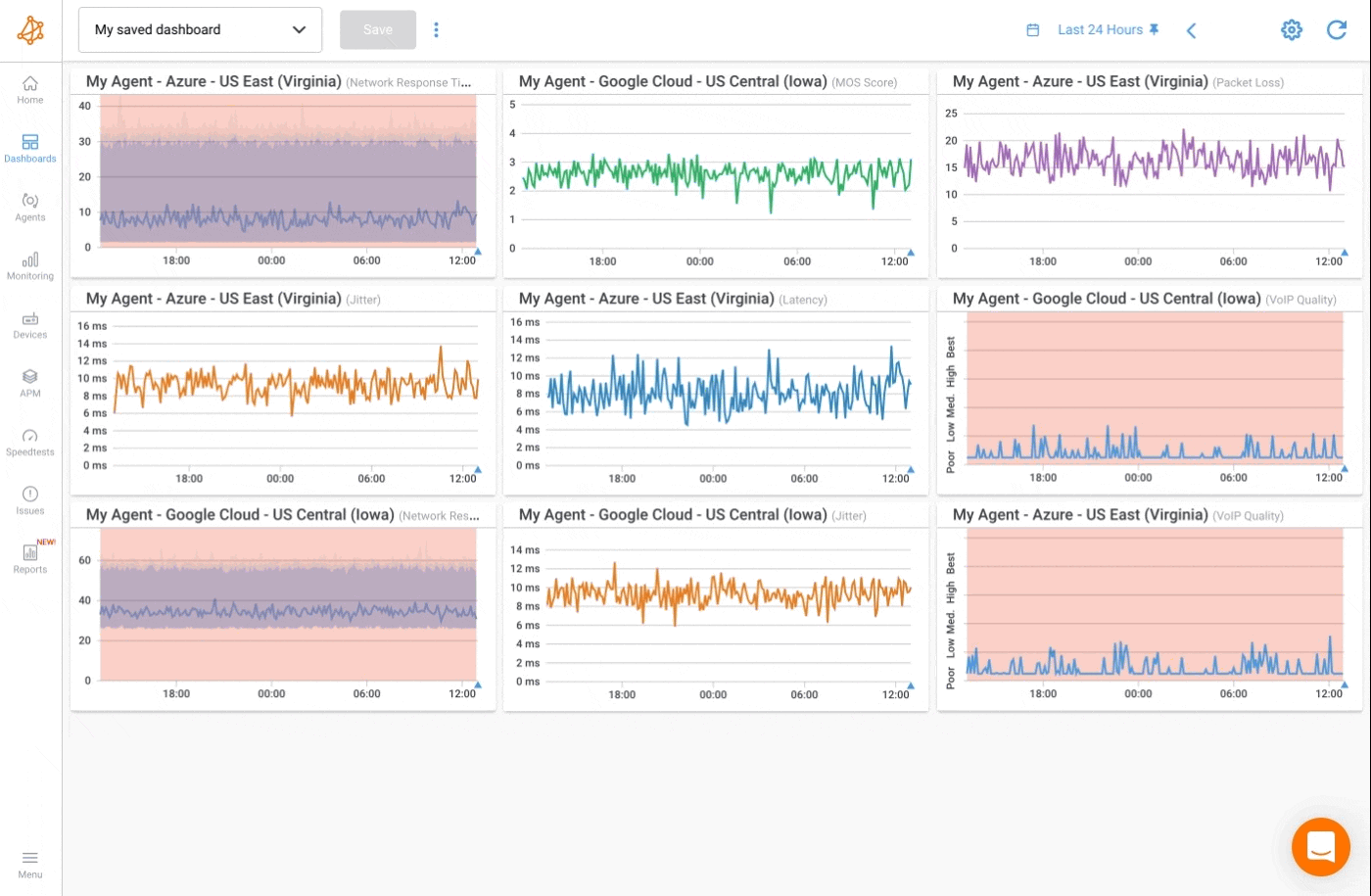
Customize your dashboard with an intuitive interface that effectively presents network data.

Network Monitoring Best Practice #8. Identify & Troubleshooting Internal (LAN) vs. External (WAN) Network Issues
A crucial aspect of effective network troubleshooting involves distinguishing between internal (LAN) and external (WAN) issues swiftly. This differentiation is essential for accurately pinpointing the source of the problem and putting the right people to resolve it.
Imagine 2 scenarios:
Your team reports connectivity issues. With a quick look into your network monitoring software, you determine it's either a LAN or WAN problem.
- If it's a LAN issue – let’s say the router at the office is not responding since settings are outdated and you need to force an update. In this case, you're the one who needs to step up, troubleshoot with your internal team, and save the day.
- But, what if it's a WAN glitch? You gather the evidence needed to prove it's on your MSP's end/ in the MSP network. For example, by running a traceroute tool, you’ve identified a high packet loss on your ISP’s end. Then all you need to do is to escalate the support case and ensure a swift resolution with your provider.
- By swiftly identifying the nature of the issue, you can efficiently allocate resources.
- Troubleshooting efforts can be quickly directed to the appropriate team, optimizing workflow and minimizing confusion between your teams.
Accelerated issue resolution with targeted troubleshooting efforts, ultimately reducing downtime and enhancing the overall user experience. The streamlined communication process with internal and external teams facilitates collaborative problem-solving, ensuring faster and more effective solutions.
In the dynamic world of connectivity, every second counts. Armed with these network monitoring best practices, the power is in your hands now! Don't delay, take charge of your network's health, troubleshoot issues proactively, and set up robust network monitoring techniques.
By embracing these practices, you not only optimize network performance but also improve customer experience, increase revenue and automate operational workflow.
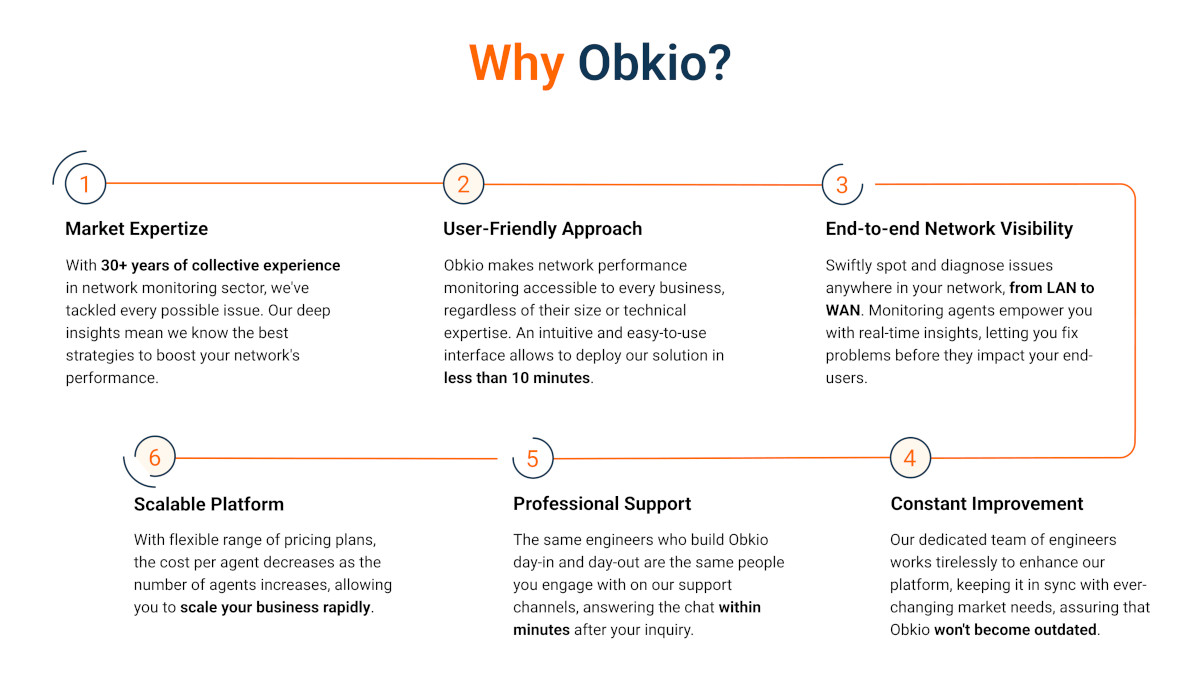
In essence, the mantra for effective network monitoring is "monitor network performance now, not later." And when it comes to putting this mantra into action, Obkio's Network Monitoring tool is your go-to partner.
Ready to elevate your network monitoring game?



























 Obkio Blog
Obkio Blog





